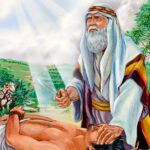Introduction: A Prophet in Exile
The Book of Ezekiel stands as one of the most profound and visionary writings in the Old Testament. Written by the prophet Ezekiel, a priest turned exile, this book bridges two major biblical themes: judgment and restoration. It is a work of divine revelation that combines vivid imagery, symbolic acts, and powerful oracles to reveal God’s holiness, justice, and mercy.
Ezekiel’s ministry began during one of Israel’s darkest periods—the Babylonian exile. In 597 B.C., Ezekiel was taken captive to Babylon along with King Jehoiachin and other prominent citizens. Far from home, he received visions that explained why Jerusalem had fallen and what hope awaited God’s people beyond their suffering.
Through Ezekiel, God spoke to a broken nation: judgment was certain because of sin, but restoration was promised through divine mercy. His message remains relevant today, reminding believers that God’s discipline is never without purpose and His faithfulness never fails.
Understanding the Book of Daniel: Prophecy and Sovereignty
HISTORICAL CONTEXT: A PROPHET IN CAPTIVITY
To grasp the significance of Ezekiel’s message, one must understand the historical setting.
The kingdom of Judah had persisted in idolatry, injustice, and rebellion despite repeated warnings from prophets like Isaiah and Jeremiah. As a result, Babylon, under King Nebuchadnezzar, invaded Judah multiple times. The first deportation in 605 B.C. included Daniel and other young nobles. The second, in 597 B.C., carried Ezekiel into exile.
By 586 B.C., Jerusalem and the temple were completely destroyed. The people questioned God’s justice and faithfulness: How could this happen to the chosen nation?
It was in this setting of despair that God called Ezekiel to speak—not from Jerusalem’s temple, but from Babylon’s plains. His task was to interpret the meaning of Israel’s suffering and proclaim both divine judgment for sin and hope for renewal.
Understanding the Book of Psalms: Worship and Prayer
Ezekiel 2:3–4 (NIV) – “Son of man, I am sending you to the Israelites, to a rebellious nation that has rebelled against me… The people to whom I am sending you are obstinate and stubborn.”
Ezekiel’s call shows that his audience was not just Babylon’s captives, but a spiritually hardened people who needed both rebuke and reassurance.
AUTHORSHIP AND STRUCTURE OF THE BOOK OF EZEKIEL
The Book of Ezekiel is divided into three major sections, each reflecting a different phase of God’s message:
- Chapters 1–24: Judgment on Judah and Jerusalem
- Chapters 25–32: Judgment on foreign nations
- Chapters 33–48: Restoration and future glory
Ezekiel’s prophecies combine narrative, poetry, and symbolic acts. His ministry spanned about 22 years (593–571 B.C.), covering events before and after the fall of Jerusalem.
Understanding the Book of Jeremiah: Judgment and Restoration
The book opens with Ezekiel’s vision of God’s glory, emphasizing divine sovereignty even in exile, and ends with a vision of a renewed temple and restored land, symbolizing hope and reconciliation.
MAJOR THEMES IN THE BOOK OF EZEKIEL
A. The Glory and Holiness of God
Ezekiel begins with one of the most mysterious and majestic visions in Scripture—a stormy wind, flashing lightning, and four living creatures carrying a divine throne (Ezekiel 1). This vision of God’s glory reveals that God’s presence is not limited to Jerusalem or the temple; He reigns everywhere.
Ezekiel 1:28 (NIV) – “This was the appearance of the likeness of the glory of the Lord. When I saw it, I fell facedown, and I heard the voice of one speaking.”
This theme of God’s glory—Hebrew kavod—runs throughout the book. It departs from the corrupt temple (Ezekiel 10–11) but later returns to the restored temple (Ezekiel 43), symbolizing divine restoration.
Lesson: God’s holiness demands reverence, and His glory cannot coexist with sin. Yet His glory will return when hearts are purified.
B. Judgment for Sin
Ezekiel’s early prophecies deliver a clear message: the exile was a result of Israel’s rebellion. God’s judgment was not arbitrary but the outcome of persistent disobedience—idolatry, violence, and moral corruption.
Understanding the Book of Song of Solomon: Love and Intimacy
Ezekiel 7:3–4 (NIV) – “The end is now upon you, and I will unleash my anger against you. I will judge you according to your conduct and repay you for all your detestable practices.”
Ezekiel uses powerful symbolism to depict judgment:
- The watchman (Ezekiel 3, 33) warns of coming disaster.
- The siege of Jerusalem (Ezekiel 4–5) is dramatized by Ezekiel lying on his side and eating rationed food.
- The unfaithful wife (Ezekiel 16 and 23) represents Israel’s spiritual adultery through idol worship.
These acts were meant to awaken the people’s conscience and show that God’s justice cannot be ignored.
Modern Reflection: Sin still separates people from God. Just as Israel’s idolatry led to exile, modern believers must guard against spiritual complacency and moral compromise.
C. Individual Responsibility
A remarkable feature of Ezekiel’s message is his emphasis on personal accountability. In contrast to the belief that individuals suffered for their ancestors’ sins, Ezekiel proclaimed that everyone is responsible for their own actions.
Ezekiel 18:20 (NIV) – “The one who sins is the one who will die. The child will not share the guilt of the parent, nor will the parent share the guilt of the child.”
Understanding the Book of Isaiah: Prophecy and Redemption
This principle underscores the fairness of divine judgment. God deals with people justly, according to their own choices. It also introduces the possibility of repentance and forgiveness for anyone willing to turn from sin.
D. The Call to Repentance
Despite the severity of judgment, Ezekiel constantly appeals for repentance. God takes no pleasure in destruction; His desire is that sinners turn and live.
Ezekiel 33:11 (NIV) – “As surely as I live, declares the Sovereign Lord, I take no pleasure in the death of the wicked, but rather that they turn from their ways and live.”
Repentance is the key that turns divine wrath into mercy. Ezekiel’s prophetic call echoes through time: no one is beyond God’s forgiveness when they truly repent.
E. The Promise of Restoration
The second half of Ezekiel transitions from judgment to hope and restoration. Once Jerusalem falls, Ezekiel’s message shifts to renewal — the assurance that God will bring His people back and give them new life.
Ezekiel 36:26–27 (NIV) – “I will give you a new heart and put a new spirit in you; I will remove from you your heart of stone and give you a heart of flesh. And I will put my Spirit in you and move you to follow my decrees.”
This passage captures the heart of God’s redemptive plan — spiritual transformation through the Holy Spirit. Restoration was not just about rebuilding walls but renewing hearts.
Understanding the Book of Proverbs: Wisdom and Virtue
F. The Vision of the Dry Bones
One of the most famous visions in Ezekiel is the Valley of Dry Bones (Ezekiel 37). In this vision, Ezekiel sees a valley filled with lifeless bones. As he prophesies, the bones come together, flesh covers them, and breath enters them—they become a living army.
This powerful image symbolizes Israel’s national and spiritual revival. Though the nation seemed dead, God promised to breathe new life into His people and bring them back from exile.
Ezekiel 37:5 (NIV) – “This is what the Sovereign Lord says to these bones: I will make breath enter you, and you will come to life.”
For modern readers, this vision reminds us that no situation is too hopeless for God’s restoration.
G. The New Temple and God’s Presence
In the final chapters (Ezekiel 40–48), the prophet receives a detailed vision of a new temple, a renewed land, and a restored worship system. This vision symbolizes the return of God’s presence to His people and the reordering of creation under divine rule.
Ezekiel 43:2 (NIV) – “The glory of the God of Israel was coming from the east… and the land was radiant with his glory.”
The closing verse summarizes the message of hope:
Ezekiel 48:35 (NIV) – “And the name of the city from that time on will be: The Lord is there (Yahweh Shammah).”
This is the climax of restoration — not merely physical rebuilding but the return of God’s presence among His people.
Understanding the Book of Lamentations: Grief and Hope
SYMBOLISM AND PROPHETIC IMAGERY IN EZEKIEL
Ezekiel is known for his symbolic actions and apocalyptic imagery, which convey deep spiritual truths:
- The Vision of God’s Throne (Ezekiel 1): Depicts divine majesty and omnipresence.
- The Eating of the Scroll (Ezekiel 3): Symbolizes internalizing God’s message.
- The Departing Glory (Ezekiel 10–11): Illustrates divine withdrawal due to sin.
- The Two Sticks (Ezekiel 37:15–28): Represents the reunification of Israel and Judah.
- Gog and Magog (Ezekiel 38–39): Symbolizes final victory over evil powers.
Each vision builds upon the central truth that God reigns over all creation, and His purposes will ultimately prevail.
CHRIST FORESHADOWED IN THE BOOK OF EZEKIEL
Ezekiel’s prophecies point forward to Jesus Christ, the ultimate Shepherd and Restorer of God’s people.
- The Good Shepherd (Ezekiel 34:23–24): God promises to raise up one Shepherd — fulfilled in Christ (John 10:11).
- The New Heart and Spirit (Ezekiel 36:26–27): Anticipates the indwelling of the Holy Spirit through the New Covenant (Romans 8:9–11).
- The Temple Presence (Ezekiel 43): Fulfilled in Jesus, in whom the fullness of God dwells (John 2:19–21; Colossians 2:9).
Thus, Ezekiel’s message of judgment and restoration finds ultimate completion in Christ — the One who bore our judgment and brings eternal restoration.
LESSONS FROM THE BOOK OF EZEKIEL
1. God’s Holiness Is Unchanging
God’s glory cannot dwell where sin reigns. The call to holiness is as vital today as it was in Ezekiel’s time.
2. Judgment Is Real but Redemptive
Divine discipline is not meant to destroy but to correct and bring people back to righteousness.
3. Repentance Leads to Renewal
Ezekiel teaches that genuine repentance opens the door for transformation and new life through God’s Spirit.
4. Hope Is Never Lost
Even in exile, God was at work. The vision of the dry bones proves that God can revive what seems beyond repair.
5. God’s Presence Is Our Ultimate Reward
The book ends with “The Lord is there” — a reminder that the greatest blessing is living in God’s presence forever.
Understanding the Book of Ecclesiastes: Life’s Meaning
RELEVANCE OF EZEKIEL’S MESSAGE TODAY
In today’s world of spiritual decay, injustice, and moral compromise, Ezekiel’s message is strikingly relevant.
- For individuals, it calls for inner renewal and obedience to God’s Spirit.
- For nations, it warns that pride and idolatry lead to destruction.
- For the church, it reaffirms the hope of God’s presence and the mission to proclaim restoration to a broken world.
Ezekiel’s vision encourages believers to trust that God is sovereign even in exile, and His promises of restoration are sure.
CONCLUSION: FROM JUDGMENT TO GLORY
The Book of Ezekiel is a journey from despair to divine glory. It begins with judgment but ends with restoration — from the departure of God’s presence to His triumphant return.
Through Ezekiel, God reveals that His justice is perfect, His mercy is infinite, and His glory will once again fill the earth. For every believer facing spiritual dryness or uncertainty, Ezekiel offers this eternal truth: no matter how deep the exile, God’s restoration is always possible.
Ezekiel 37:14 (NIV) – “I will put my Spirit in you and you will live, and I will settle you in your own land. Then you will know that I the Lord have spoken, and I have done it.”
Understanding The Old Testament: Genesis to Malachi
In the end, Ezekiel’s message of judgment and restoration points to the ultimate hope found in Jesus Christ — the living temple of God and the source of eternal renewal.
Last modified: November 10, 2025

